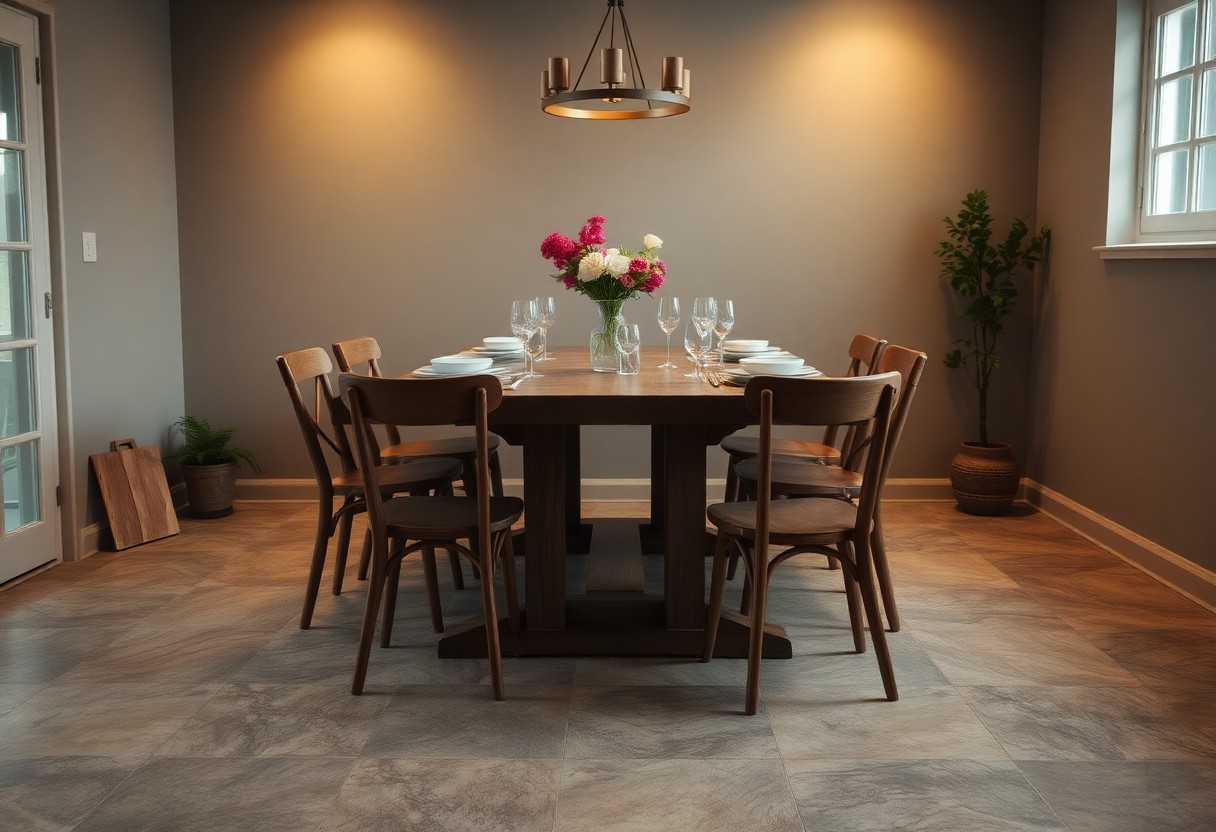It’s vital to consider the impact of flooring on your home’s overall aesthetic and functionality. Dry back vinyl flooring not only offers a stylish appearance but also provides durability and ease of maintenance, making it an excellent choice for any space. With a variety of designs available, you can achieve the look you desire while enjoying the long-lasting benefits of this resilient flooring option. Discover how dry back vinyl can transform your home into a beautiful and practical environment.
Understanding Dry Back Vinyl Flooring
Dry back vinyl flooring refers to a type of resilient flooring that is glued down directly to the subfloor, offering a durable and stable option for any space. This installation method eliminates the movement often found in floating floors, ensuring that your flooring remains securely in place. Its composition typically includes layers for support, aesthetics, and protection, providing a long-lasting finish that combines functionality and style.
Composition and Structure
The structure of dry back vinyl flooring consists of multiple layers that contribute to its durability and performance. Generally, it includes a backing layer, a core layer made from polyvinyl chloride (PVC), a printed design layer for aesthetics, and a protective top layer that guards against scratches and stains. This composite design ensures your floors withstand daily wear while mimicking the look of natural materials such as wood or stone.
Benefits of Dry Back Vinyl
Choosing dry back vinyl flooring brings numerous advantages for your home, including enhanced durability, ease of maintenance, and versatile design options. The installation method ensures that the floor remains stable, making it ideal for high-traffic areas. Additionally, its waterproof nature makes it suitable for kitchens and bathrooms, while the variety of styles allows you to customize your space according to your personal taste.
The long-lasting nature of dry back vinyl flooring means that you’ll invest in a solution that stands the test of time. With proper care, it can last up to 20 years or more, proving especially cost-effective compared to other flooring types. Its resistance to moisture and humidity issues makes it a reliable choice for any environment, whether in a bustling family home or a serene retreat. Furthermore, the floors are designed to retain their look without the need for heavy maintenance, allowing you to enjoy your space without constant upkeep.
Aesthetic Appeal of Dry Back Vinyl Flooring
Dry back vinyl flooring offers an exceptional blend of beauty and functionality, making it an ideal choice for any room in your home. Its elegant designs replicate the look of natural materials like hardwood and stone while providing the durability and ease of maintenance that vinyl is known for. You can easily enhance the aesthetic of your space with options that fit both modern and traditional décor themes.
Design Options and Styles
With a wide array of design options available, dry back vinyl flooring caters to diverse tastes. Whether you’re drawn to the rustic charm of reclaimed wood or the sleek sophistication of polished tiles, you have countless possibilities. Many manufacturers provide collections inspired by global trends, allowing you to personalize your space to reflect your unique style.
Color and Texture Choices
Your choice of color and texture can dramatically influence the overall ambiance of a room. Dry back vinyl flooring comes in an extensive palette, from muted earth tones to vibrant hues, accommodating every aesthetic preference. Additionally, textures range from high-gloss finishes to realistic embossed surfaces, creating depth and interest that enhance your home’s visual appeal.
When deciding on colors, consider how they interact with existing furnishings and lighting. For instance, lighter shades tend to create an open and airy feel, making smaller spaces appear larger. Alternatively, darker tones can add warmth and sophistication. Texturally, embossed surfaces can mimic the feel of natural stone or wood, enhancing realism and inviting touch. Think about your desired atmosphere; a subtle texture may create a calm, understated look, while a more pronounced finish adds character and energy to your décor.

Durability and Longevity
Your investment in dry back vinyl flooring pays off through its impressive durability and longevity. Designed to withstand the rigors of daily life, it holds up against scratches, dents, and fading, ensuring that your floors look great for years to come. This resilience makes it a favored choice among homeowners seeking flooring options that offer both style and durability, allowing you to enjoy your beautiful space without constant worry about wear and tear.
Resistance to Wear and Tear
You’ll appreciate that dry back vinyl flooring is engineered with a robust wear layer, which acts as a shield against the daily hustle and bustle of life. This flooring is resistant to scratches, stains, and scuffs, making it ideal for high-traffic areas of your home. With proper maintenance, this flooring can maintain its pristine appearance and longevity, offering peace of mind for families and pet owners alike.
Maintenance Requirements
Caring for dry back vinyl flooring is straightforward and hassle-free. Regular sweeping and damp mopping are typically all it takes to keep the surface clean and looking new. Unlike natural materials that may require sealing or special cleaning products, vinyl’s non-porous surface is designed to resist dirt and grime buildup, making your cleaning routine much simpler.
In terms of maintenance, avoid using abrasive cleaners or scouring pads that could damage the surface. Instead, employ gentle, pH-balanced cleaners specifically formulated for vinyl. Spills can be quickly wiped away without worry, and the occasional deep clean with a manufacturer-recommended product can enhance its longevity. Your flooring can remain beautiful for years with minimal effort, allowing you to focus on enjoying your home rather than worrying about upkeep.
Installation Process
Installing dry back vinyl flooring is a straightforward process that can transform your space with minimal effort. You can achieve a professional look by following the correct steps to ensure a seamless finish. It’s important to approach this task with proper preparation and the right tools at your disposal.
Preparation and Tools Needed
Before you begin, gather the necessary tools and prepare the installation area. Ensure your subfloor is clean, dry, and level to achieve the best results. Key tools include a utility knife, straight edge, measuring tape, and an adhesive recommended by your flooring manufacturer.
Step-by-Step Installation Guide
Begin the installation by measuring your room to determine the layout. Cut the vinyl planks accordingly, then apply the adhesive following the manufacturer’s instructions. Lay the planks from one corner, pressing firmly into the adhesive and ensuring a tight seam. Continue until the entire area is covered, and allow sufficient time for the adhesive to cure.
Tools Required for Installation
| Utility Knife | For cutting the vinyl planks accurately |
| Straight Edge | To guide your cuts and maintain straight lines |
| Measuring Tape | For precise measurements of the installation area |
| Adhesive | Manufacturer-recommended adhesive for best results |
Step-by-Step Guide Breakdown
| Measure the Room | Accurate measurements ensure a proper fit of the planks. |
| Prepare the Subfloor | Ensure cleanliness and levelness to avoid issues during installation. |
| Apply Adhesive | Follow manufacturer guidelines for adhesive application. |
| Lay the Planks | Position each plank snugly and press down to adhere. |
| Allow to Cure | Let the adhesive set as per guidelines for optimal results. |
Cost-Effectiveness
Dry back vinyl flooring stands out for its cost-effectiveness, providing a beautiful finish without the high price tag of other materials. Installation and maintenance costs are significantly lower compared to hardwood or natural stone, making it an attractive choice for budget-conscious homeowners. You will find that the longevity of this flooring reduces the need for frequent replacements, giving you greater value over time.
Comparison with Other Flooring Types
When comparing dry back vinyl flooring to other options, such as hardwood, laminate, or tile, its affordability shines through. Here’s a quick breakdown:
| Flooring Type | Average Cost per Square Foot |
| Dry Back Vinyl | $2 – $5 |
| Hardwood | $8 – $12 |
| Laminate | $1 – $4 |
| Tile | $5 – $10 |
Thou will appreciate that dry back vinyl flooring combines aesthetics with functionality, making it a smart investment choice.
Long-Term Investment Value
The long-term investment value of dry back vinyl flooring is notable, as its resilience means you can enjoy the same beautiful floors for years without the stress of frequent repairs or replacements. Withstanding heavy foot traffic and everyday spills, this flooring ranks highly in terms of return on investment.
In practical terms, the low maintenance requirements not only save you time but also significantly reduce costs over the years. For example, regular sweeping and occasional damp mopping are all that’s needed to keep your floors looking new. Moreover, given its resistance to stains and scratches, you won’t need to worry as much about professional cleaning services. When examining the total cost of ownership, dry back vinyl flooring clearly outshines alternatives, ensuring your financial resources are well spent while enhancing your home’s beauty and utility.
Environmental Considerations
When choosing dry back vinyl flooring, it’s imperative to assess its environmental impact. This category of flooring is engineered to minimize waste and optimize the use of resources, making it a choice that aligns with eco-friendly values. Additionally, many manufacturers are adopting responsible practices to reduce energy consumption in production, ensuring that your home improvement also contributes positively to the planet.
Sustainability of Materials
Your choice in dry back vinyl flooring can reflect a commitment to sustainability. Many options are made from recycled materials, with some brands using up to 30% post-consumer content. This not only reduces waste but also lessens the need for new raw materials, promoting a circular economy that benefits the environment.
Indoor Air Quality Benefits
Opting for dry back vinyl flooring has significant implications for indoor air quality. Many products are designed with low-VOC (volatile organic compounds) materials, which contribute to healthier air in your home. With fewer harmful emissions, you can enjoy a space that safeguards your well-being while maintaining a stylish appearance.
Low-VOC options in dry back vinyl flooring greatly reduce harmful emissions that can linger in your home environment. Unlike traditional flooring materials, which may release volatile compounds, dry back vinyl tends to be engineered with air quality considerations in mind. This means when you walk into your rooms, you’re not only greeted with aesthetic beauty but also an atmosphere conducive to health, making it a wise choice for those with allergies or sensitivities. By choosing low-VOC flooring, your home becomes a sanctuary free from pollutants, enhancing both comfort and the quality of life.
Final Words
Considering all points, dry back vinyl flooring is an outstanding choice for enhancing your home’s beauty and functionality. Its blend of durability, ease of maintenance, and stylish designs ensures that your floors will not only withstand the test of time but also elevate your interior aesthetics. By opting for this versatile flooring solution, you can enjoy the perfect balance of elegance and practicality, making it a smart investment for any homeowner seeking long-lasting beauty.





